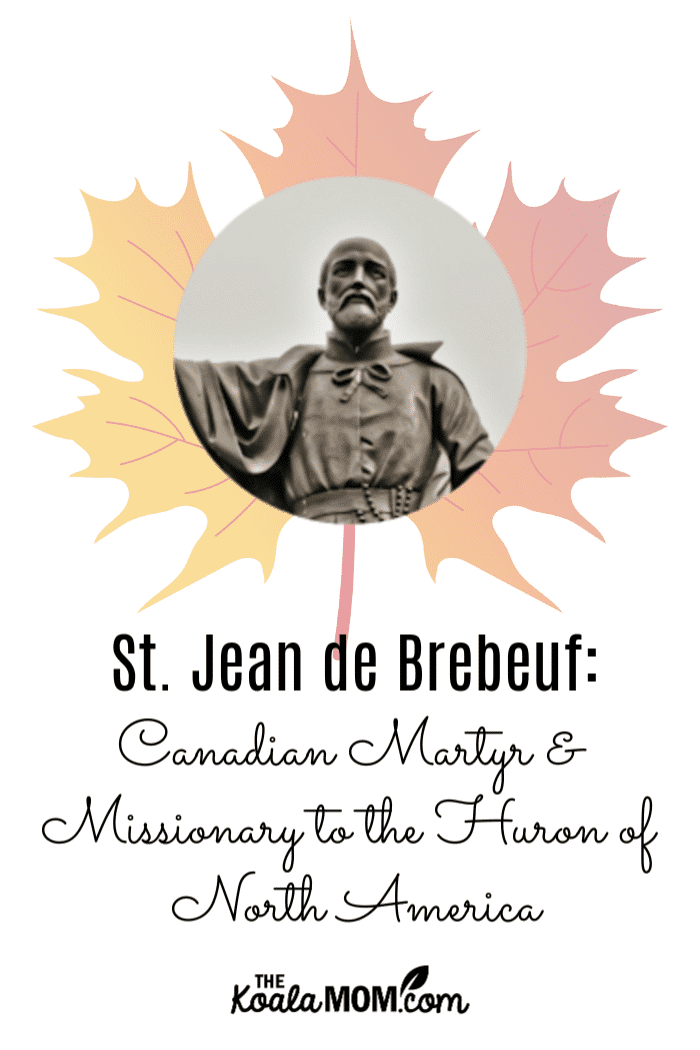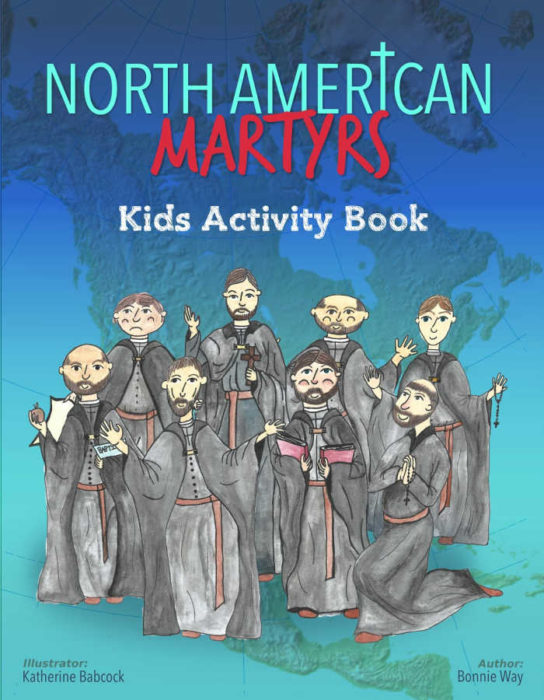Saint Jean de Brebeuf is the patron saint of Canada and the oldest of the eight Canadian martyrs. He was told more than once that he couldn’t pursue his vocation as a missionary, because of either his health problems or his size.
Often as moms, we are told similar things. Doctors may tell us that our bodies aren’t suited for conception or natural birth. Health problems may make us question whether we’d be good moms or not. Yet St. Jean didn’t let these “no’s” stop him from doing what God had called him to do. We can ask him to pray for us as we discern and pursue our own vocations as moms.

Saint Jean de Brebeuf was born in Normandy, France, on March 25, 1593. According to The Catholic Encyclopedia, he wanted only to serve the Jesuits as a lay brother. He joined the order in October or November 1617 after studying humanities, philosophy, and moral theology.
Four years later, his studied were interrupted by health problems (likely tuberculosis), limiting his theological knowledge. Historian John J. Wynne says “he could not make the usual studies of the young Jesuit, nor could he teach for any length of time” (The Jesuit Martyrs of North America). Despite this, he “studied theology sufficiently to qualify for ordination in the unusually short time, for one of his Order, of six years” (Wynne) and was ordained in 1622.
Saint Jean de Brebeuf arrives in New France
He arrived in New France in June 1625. There he spent the winter on a hunting expedition with the Montagnais, learning to travel and eat like a native. The following summer, a group of Huron arrived in Quebec to trade. Fr. Brébeuf asked to accompany them back to their village. The Huron originally declined to take Fr. Brébeuf because of his huge stature. With some bribes, he “was permitted into a canoe on the condition he would not move” (Jesuit Curia in Rome).
During the trip, Fr. Brébeuf’s great strength came in handy over the many portages. Wynne notes that the trip from Quebec to Huronia “was no pleasure-trip. The distance from Quebec is not more than six hundred miles. The trail and water route, however, was fully nine hundred, owing to the need of avoiding difficult country, and of keeping away from the Iroquois.” They arrived safely in Huronia and established the first Jesuit mission near Georgian Bay.
Saint Jean de Brebeuf with the Hurons
From 1626 to 1629, Fr. Brébeuf worked to learn the Huron language and customs. He apparently had a gift for languages and soon wrote a Huron grammar, as well as a catechism and phrase book. He observed the Indians playing a game they called baggataway, and may have been the one to suggest its modern name, based on the similarity of the stick used to a bishop’s crozier (la crosse).
His fellow priest soon returned to Quebec, leaving Fr. Brébeuf alone with the Hurons. Wynne says he “showed extraordinary physical courage in dwelling alone with these people. His moral courage was greater still. Not only did he fail to make any converts among them; he soon discovered that they were suspicious of everything about him.” Droughts, diseases, and other misfortunes were blamed on Fr. Brébeuf.
Nearly a decade later, Fr. Brébeuf wrote a set of brief instructions to other missionaries based on his work among the Hurons (Saints.SQPN.com). These include such pieces of advice as “Do not begin to paddle unless you intend always to paddle” and “The Indians will keep later that opinion of you which they have formed during the trip.” He also recommended courtesy, cheerfulness and patience towards the Indians, saying, “You must love these Hurons, ransomed by the blood of the Son of God, as brothers.”
The Return to France
In 1629, the French and English ended their war and Quebec was given over to the English. Fr. Brébeuf returned to Rouen and “while there made his final year of probation, the crowning observance of the Jesuit in preparation for his life’s work” (Wynne).
Quebec was returned to France in 1633 and Fr. Brébeuf returned to his missionary work. As Wynne says, “One would imagine that after his experiences with the Indians he might have turned his thoughts to other fields where the harvest would be more promising. On the contrary, suffering had only whetted his appetite for more.” More suffering was to be his fate on his second missionary trip to New France.
Saint Jean de Brebeuf’s Second Missionary Trip
 In 1632, England and France signed a treaty returning Quebec to the French. Fr. Brebeuf, along with Fr. Anthony Daniel, returned to the Huron missions. Despite the fact that Fr. Brebeuf had made no converts in his first missionary journey, he had apparently formed good relationships with the Huron. They “lamented the loss of their robust and intelligent priest who regarded the Natives as his own brothers and sisters” (Schmidt). On his return, however, Fr. Brebeuf found it difficult to re-establish relationships.
In 1632, England and France signed a treaty returning Quebec to the French. Fr. Brebeuf, along with Fr. Anthony Daniel, returned to the Huron missions. Despite the fact that Fr. Brebeuf had made no converts in his first missionary journey, he had apparently formed good relationships with the Huron. They “lamented the loss of their robust and intelligent priest who regarded the Natives as his own brothers and sisters” (Schmidt). On his return, however, Fr. Brebeuf found it difficult to re-establish relationships.
Political problems abounded, despite the truce with England. Samuel de Champlain, the re-appointed lieutenant general, had to partially rebuild Quebec. The Iroquois, who traded mostly with the Dutch, attacked the Huron and the French repeatedly and blockaded their trade routes. This postponed the missionaries’ journey to Huronia from 1933 to 1934, and when Fr. Brebeuf and Fr. Daniel did go, it was “by a more desolate northern route that included eight hundred miles by canoe” (Schmidt).
The Mission to the Hurons
Arriving at Ihonatiria (near the village where he had lived from 1626-1629) in 1934, Fr. Brebeuf was named Superior of the Jesuit missions. He held this position for the next four years. With help from the Hurons, the priests built themselves a dwelling, similar to those of the Huron. Fr. Brebeuf compared them to “bowers or garden arbors—some of which, in place of branches and vegetation, are covered with cedar bark, some others with large pieces of ash, elm, fir, or spruce bark” (John Wynne, The Jesuit Martyrs of North America).
Besides teaching the Huron, Fr. Brebeuf also taught Fr. Daniel to speak Huron. They found it hard to overcome the superstitions of the Huron. During their first year, they baptized only twelve, all of whom were ill or elderly and about to die. Historian John J. Wynne explains that they would “confer baptism on adults only after mature preparation and proof of constancy.”
During Fr. Brebeuf’s years at Ihonatiria, illness ravaged the Huron. Latourelle notes, “The epidemics of 1634 (smallpox combined with dysentery), 1636 (malignant influenza), and 1639 (smallpox), reduced to 12,000 a population that Sagard, Brébeuf, and Champlain estimated at 30,000 souls.”
These epidemics were blamed on the missionaries. In 1637, Fr. Brebeuf wrote a letter to his superior predicting that they could be massacred. That year also had some good news, though: the priest baptized their first healthy adult convert.
The Jesuit Village of Ste. Marie
In 1636, Fr. Daniel returned to Quebec to found a boys’ school and Fr. Isaac Jogues joined Fr. Brebeuf in the mission. Two years later, Fr. Brebeuf established a new mission at Teanaostaiaë. It was beset by difficulties, however, especially when the smallpox epidemic of 1639 caused riots, beatings, and the desertion of most of his converts.
The rivalries of the various Huron villages caused the missionaries to change their tactics in 1639. Fr. Brebeuf and his companions established a new village, Ste. Marie, on the Wye River, a short distance away from their other missions. They had found that identifying with one village made them less welcome in other villages. From the new mission, they were able to make trips to new tribes as well as to their current missions.
In 1641, Fr. Brebeuf returned to Quebec, where he coordinated the missions for the next three years. During that time, he wrote the Huron Carol, still a popular Christmas song today. These were difficult times for the missions, as the threat from the Iroquois was stronger than ever. Mission convoys were often captured by the Iroquois, and in 1642, Rene Goupil became the first martyr and Fr. Isaac Jogues spent a year as an Iroquois prisoner.
Saint Jean de Brebeuf’s Final Years
Fr. Brebeuf returned to his work among the Huron in 1644. In the next four years, three more missionaries were martyred by the Iroquois. Fr. Brebeuf had once witnessed the Iroquois torture their victim (one of his recent converts) and knew what death at their hands meant. Despite this, he remained with his people, teaching and helping.
In 1649, the Iroquois attacked the village where Fr. Brebeuf was serving with Fr. Lalemant. After being tortured, they were martyred on March 17.
St. Jean de Brebeuf and his fellow North American Martyrs were canonized in 1930. Their feast day is celebrated in Canada on September 26 and in the United States on October 19.
St. Jean, you fearlessly pursed God’s calling upon your life, ignoring the opinions of those who tried to stop you. Even health problems could not keep you from your vocation. Pray that we may also do what God asks of us, even if we face opposition from our friends and family. Amen.

Subscribe to my weekly email newsletter to download your FREE printable Canadian Saints & Blesseds Kids Activities Pack, which includes 8 Bingo cards with 30 Canadian saints’ and blesseds’ names, crossword puzzles and word searches, saint matching and sorting games, and a saint profile sheet. These activities are intended for kids about Grades 2+ (or children who can read and write). This Kids Activities Pack would be great for catechism classes, homeschool lessons, or a Canadian All Saints Day party.

No Responses Yet